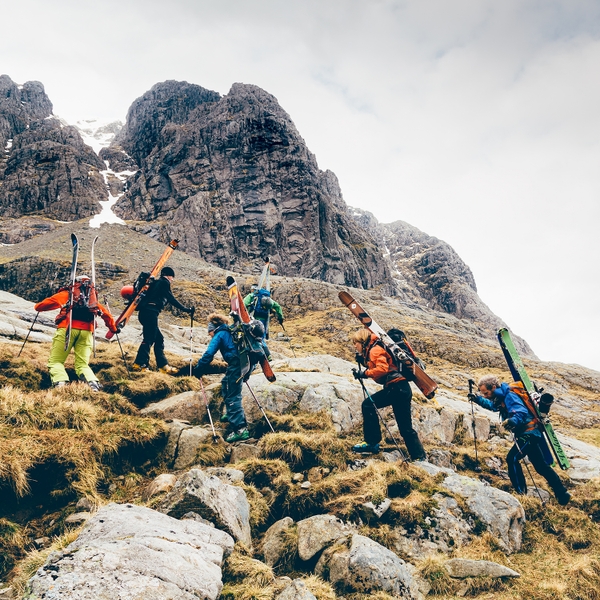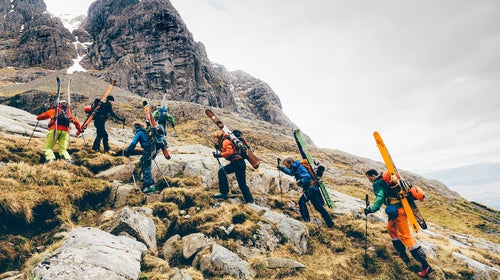Braveheart Couldn’t Handle This
Who knew that it’s easy to find great backcountry skiing in Scotland? Nobody, because it isn’t. But that doesn’t stop a committed group of hard-asses from clicking their boots and heading into the mud, rain, and heather in search of stoke.
New perk: Easily find new routes and hidden gems, upcoming running events, and more near you. Your weekly Local Running Newsletter has everything you need to lace up! .
Shortly before noon on April 29 of this year, Graham Doig, a 51-year-old engineer, hiked to the top of ’s Number Four Gully with his 15-year-old son, Finbar. One of a series of steep, granite-walled trenches that bisect the northeast face of Britain’s highest mountain, Number Four Gully rises from around 3,051 feet to a ridgeline at 3,871 feet. It’s an easy climb in winter, but the Doigs, along with other members of the , planned to ski the snow that banked between its walls. That proposition was more challenging, given that the entry gradient is at least 45 degrees.
First to the top were the Doigs, followed by Hamish Frost, a photographer based in Glasgow, and , a photographer shooting for ���ϳԹ���. I came next. Niall McPherson and James Jackson, two officers serving in Scottish regiments of the British Army, formed the rear party with Nicola Jackson, an architect. We broke through the cornice and, on flat ground beyond, stripped the skis from our packs and removed the crampons from our boots. We holstered ice axes and prepared to drop back into the gully for the descent. The view was clear and expansive; beyond the sea inlet of Loch Linnhe, serried hills stretched toward the Atlantic. Nowhere on that broad vista was there a single patch of snow to be seen. It existed only in isolated stashes like the one we’d just climbed.
Scotland’s territory sits mainly between 55 and 60 degrees north. Move that landmass to Canada and you’re in the top half of a province like Alberta. But Scotland’s climate is profoundly different from the Canadian interior. The warm Gulf Stream current, flowing up from the Gulf of Mexico, insulates the United Kingdom, keeping it significantly balmier than it should be. (Coastal British Columbia, likewise warmed by its ocean, is a better comparison, says Geoff Monk, who runs Scotland’s .) While much of the Scottish landscape is rugged, the peaks are modest. Ben Nevis, the highest, reaches just 4,413 feet.
Scottish winters played a pivotal role in the development of ice climbing and served as a crucible for some of the world’s hardiest mountaineers. But snow is elusive, and it’s possible for the mountains to be almost bare in the middle of winter. By North American standards, the country is a fundamentally marginal ski destination. It has five lift-served resorts that exist in a continual state of financial precariousness.
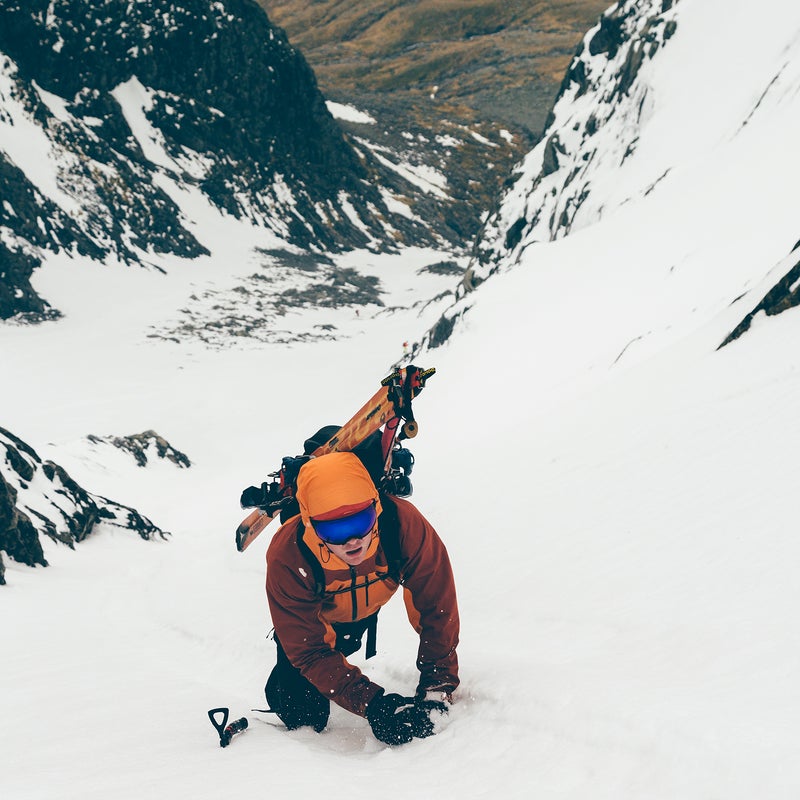
Nonetheless, the backcountry scene is exploding in Scotland, a boom driven partly by dramatic improvements in alpine-touring equipment and partly by social media’s ability to spread the word. British Backcountry, a Facebook page established in 2012, has roughly 8,700 members. Some of them are armchair enthusiasts, but in recent years the Inverness Club has seen a 10 to 15 percent annual membership gain. Sales of touring gear are up at the local outlet of Craigdon Mountain Sports.
“In the eight years I’ve been skiing off-piste in Scotland, I’ve gone from only occasionally seeing other skiers to seeing several per day, even in remote areas,” says David Anderson, a research chemist based in Edinburgh. Accessible backcountry sites can see upwards of 50 skiers and snowboarders on a good day.
There’s irony in this boom, however. According to the , the mean winter temperature rose 2.7 degrees Fahrenheit between 1960 and 2016. Last winter was the fourth-mildest in records dating back to 1910. Backcountry skiing is taking off right as climate change risks turning a niche sport into an impossible one. That speaks to a peculiar aspect of the Scottish character: resilience.
“They are very easily pleased. I think the aspirations are fairly low,” says Keith Geddes, a longtime Scottish ski coach who once trained the national team. “I’ve skied a lot of places, and it’s I think fairly unique just because of the weather. The choice is either get on with it or don’t do it, and the not-doing-it thing is just not conceivable, really.”
“It’s probably one amazing day for every 15 normal days,” says Finbar Doig. “And then every other day is, like, all right. It’s good, though, because you’re skiing.”
“There is a certain bloody-mindedness to some Scots,” says David Torrance, a prominent national political commentator. “The more they’re told not to do something, or told they can’t do something because it’s impossible, the more they want to do it.”
In mid-January, I took the overnight train from London, where I’m based, to Aviemore in the Scottish Highlands. Skiers who live in the shadows of Scottish peaks—or even in the cities of the country’s central belt, two to three hours away—can look out their windows and, if conditions seem right, make a dash for the hills. Choosing when to strike out from London, 540 miles to the south, was much more complicated. The season had started well, with snow in November, but that all melted, and little new cover followed. Snow was forecast for the next weekend, but how much was unclear. I called several Scottish skiers to get their take on probable conditions. It was like staring into a murky crystal ball.
“It’s a difficult one, obviously,” said Graeme Brown, an anesthetist in Glasgow. “There’s obviously a big system going through at the moment, and it’s pretty wild. There’s no base at all, anywhere essentially. I think there’s going to be potentially a decent amount of snowfall over the next couple of days, but it’s potentially falling onto nothing.”
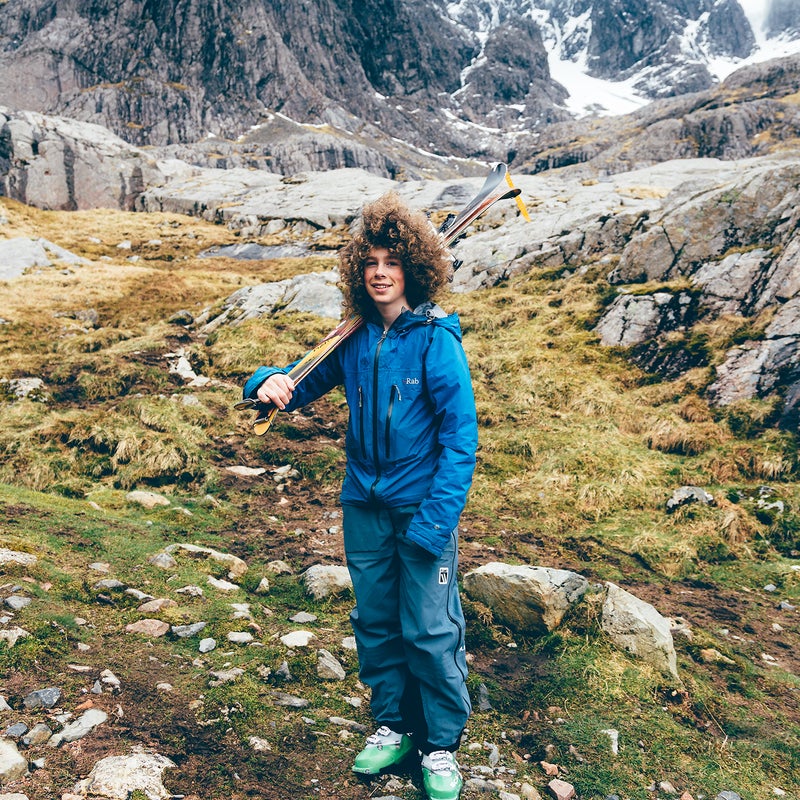
My phone buzzed with a message from Blair Aitken, founder of British Backcountry. “Actually there’s quite a bit forecast to fall on the northern Cairngorms on Thursday, a bit more Friday,” he wrote. “If the wind drops, as it might, and it clears, Saturday could be quite good.”
Brent MacGregor, a Canadian expat who now skis with the , was more circumspect. “It was blowing a hoolie across Drumochter Pass, but there’s not enough snow for any skiing,” he told me by phone from Aviemore. “This weekend is not looking great, to be perfectly honest.”
I decided to go for it anyway, and things actually seemed promising when the overnight train reached Aviemore, which sits about 700 feet above sea level. There were several inches of fresh snow on the platform, a relatively unusual occurrence at such low altitude. I took a taxi to Glenmore Lodge, Scotland’s national outdoor training center. There I met with Aitken, in person a tall, melancholy elementary school teacher. British Backcountry’s Facebook page serves as a clearinghouse for photos and videos of ambitious descents. One regular who posts there, Calum Macintyre, made a parody film with a friend, Adam Gairns, in which they plan a ski day based on a “Wi-Fi and 3G” map of Scotland, hashtagged with the phrase: “Memories fade but selfies last forever.”
Today we’d ski with two childhood friends of Aitken’s who used to race—Gavin Carruthers, also a teacher, and David Anderson, the Edinburgh chemist. As we prepped gear in the parking lot, the sky leaden overhead, I asked if I should pack sunscreen. They looked at me as if I’d proposed bringing a rhinoceros.
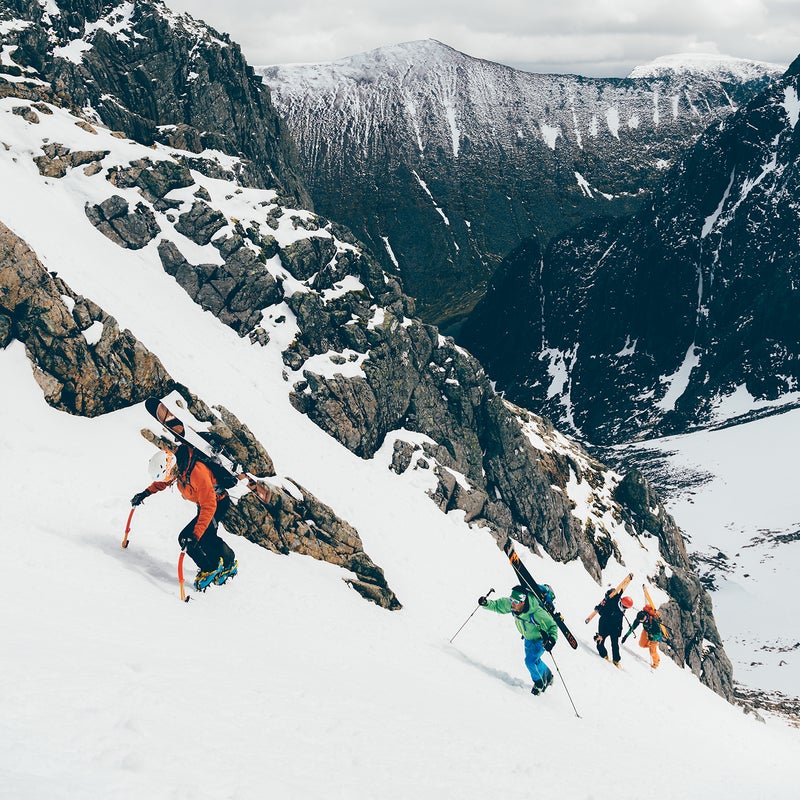
With snow cover lower down the mountains than usual, we were able to skin through the woods. Just before we reached a pool called Lochan Uaine (“Small Green Lake”), we turned left up a mountain called Meall a’Bhuachaille. We stopped short of its 2,657-foot summit. The descent, on a limited quantity of fresh snow thinly blanketing the heather, was sketchy and challenging; I was surprised that this was even considered skiing. Aitken later found better conditions by dropping into a steep line at an area called Creag Loisgte. “When I skied the trees at the top in that second run, that was like the Alps,” he later said.
That afternoon we drove to Resort, where a funicular railway climbs to a high plateau. At the exit, the wind howled and there was almost no visibility. I pulled on mittens, which iced up. We traversed around the hillside and dropped, on better snow this time, some 1,312 feet toward Strath Nethy, skiing into one of the deep valleys that drill the Cairngorm plateau. Skinning back up, we regained the plateau and hit a track off the summit of Cairn Gorm itself. Everything—rocks, fences, Gore-Tex—was rimed with ice. The scene resembled Hoth, the ice planet in the opening scene of The Empire Strikes Back.
Six miles north of Aviemore, where I left Aitken, Carruthers, and Anderson, I sat eating in a rented house in Boat of Garten, a small village, with a party from the Edinburgh Ski Touring Club. Earlier, Ingrid Baber, who organized this trip, had explained how the club reconciles the requirement for a predictable weekend program with fickle Scottish weather.
“The places we stay, some of them we reserve a year in advance, because the smaller huts get booked up,” she said. “Then we just take our chances. But for us it’s no big deal. We drive up two and a half hours and we’re in Aviemore. If there’s no snow, then we go
cycling or walking or whatever.”
I asked the various diners how often they were actually able to ski in Scotland. Their collective response: depends what you mean by skiing. The accuracy of Baber’s statement came home the next morning on the Pass of Drumochter, a broad, U-shaped valley south of Aviemore. The temperature had shot up overnight, and all was damp and thawing.
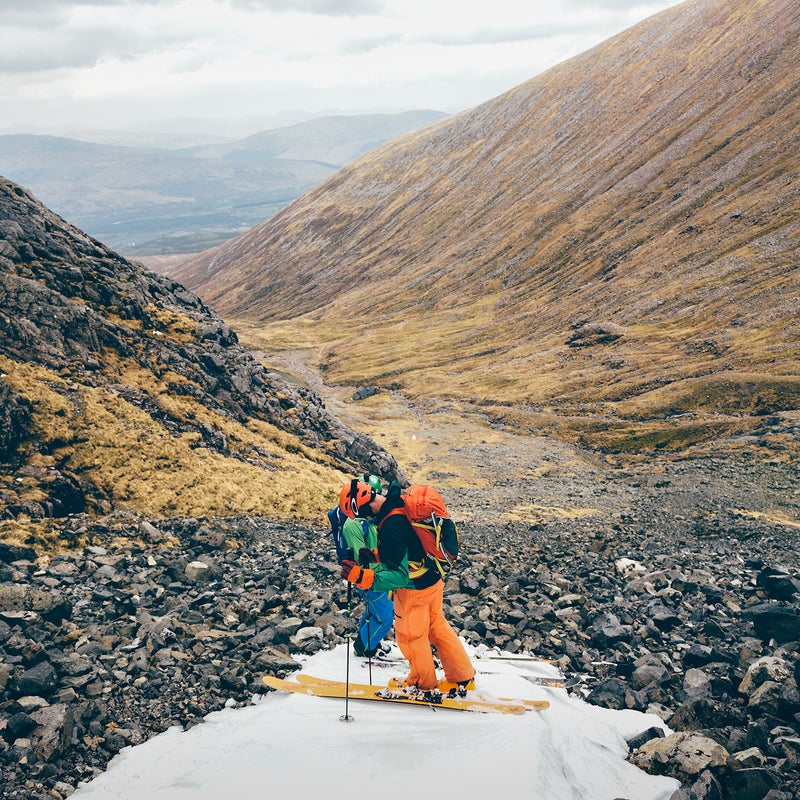
“If it’s not six degrees and raining, why would you bother?” quipped Clare Swindells, another group member, referring to the 42.8 Fahrenheit that our cars registered on the drive down.
We skied up patches of snow between heather and then linked the patches to make a descent of sorts. This group was older than Aitken’s crowd but extremely fit. At one point, I asked 68-year-old Brian Donaldson why he liked skiing in Scotland. As the wind howled, he threw my question back at me.
“Why I like skiing in Scotland? Well, the company that you ski with. We live here, so it’s easy to get to. You get some magic days, and you only get that when you’re here and you can go on the day.”
“Is this a typical Scottish ski day?”
“No. Well. It’s… you do get some of these every year. And you’ll go and do it, especially at the end of the season, just to get out.
“It gets better, honest,” he added.
In addition to the Edinburgh Club, other people share this determination to make the best of an often bad deal. After receiving a cancer diagnosis, Helen Rennie, a teacher from Inverness, made it a goal to ski in Scotland every month for a year, using the patches of semipermanent snow that linger in deep gullies and on north-facing slopes into the summer. She accomplished that goal and kept going. “I started in November 2009 and have skied on Scottish snow every month since, making a total of 95 months,” she told me. Her definition of skiing is broad, of course, never more so than in the summer of 2017, following the poor winter.
“The choice is either get on with it or don’t do it, and the not-doing-it thing is just not conceivable, really.”
“This August I had to carry my skis and boots for the best part of 11 miles to find the only remaining patch of snow on the Cairngorm plateau, on the northeast side of the north top of Ben Macdui,” she said. “It was diamond shaped and 3 meters by 2.25 meters.” That’s roughly 10 feet by 7.5 feet. Rennie’s skis are five feet long, so, as she recalled, “I had to start with them hanging off the back for one turn!”
The semipermanent snow patches vanished completely during just three years in the 20th century—1933, 1959, and 1996. In the 21st century that picture has changed: they failed to survive in both 2003 and 2006. “It’s highly likely they’ll disappear this year,” says Iain Cameron, the man behind another cultish Facebook page, Snow Patches in Scotland.
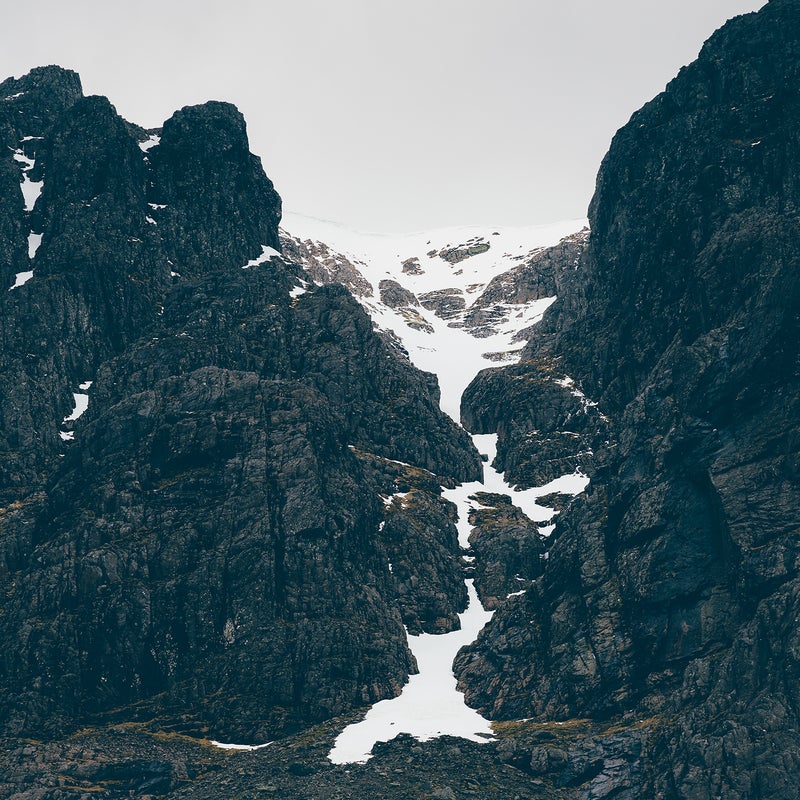
Discussion on Cameron’s page tends to the anthropomorphic, as if the melting snow was cause for bereavement. “A few of today’s Cairngorms patches for you,” Nic Bullivant wrote in a July 1 post, alongside photos. “Coire an Lochain (Cairngorm) was just hanging in there, about the size of a sixpence.”
“Still a wee bit left,” David Kellie, captioning a similar shot, wrote ten days later.
Newcomers to this community can be surprised, to say the least. “I was amazed at how much effort people will go to in Scotland to ski the tiny bits of snow they have,” says Jack Mullner, a British filmmaker based in Switzerland who directed Late, an account of an end-of-season adventure by Scottish freeriders. “We had been hiking for hours and hours to get to this tiny bit of snow, and we got up there and there was another guy, just walking along the top with his skis, like: Oh, hello!”
In the weeks after my first trip, as winter still failed to materialize, social-media chatter grew frantic. “Are the gullies on the north face of the Ben holding snow? Desperate times,” Blair Aitken wrote on January 18. “It’s approaching February and we have a stubborn high pressure. Not a good situation. Could this be Scotland’s worst ski season? Thoughts?” Rob Grant added on the 25th. “Let’s all move to Iceland,” Gordon Fraser suggested on February 17.
On several nights in early March, I called Di Gilbert, a mountaineering instructor who in 2012 cofounded a race series called Skimo Scotland. I wanted to know if a competition scheduled for the following weekend at Nevis Range, a ski resort on the west coast, would indeed take place.
“I’m always on the fence, because it can all change in the 24 hours before a race day,” she told me on Tuesday of that week. “I’m pretty sure I’ve got enough snow to have a course—of sorts. But they are forecasting big winds on Thursday, and I haven’t seen a forecast today, so that is going on yesterday’s forecast.”
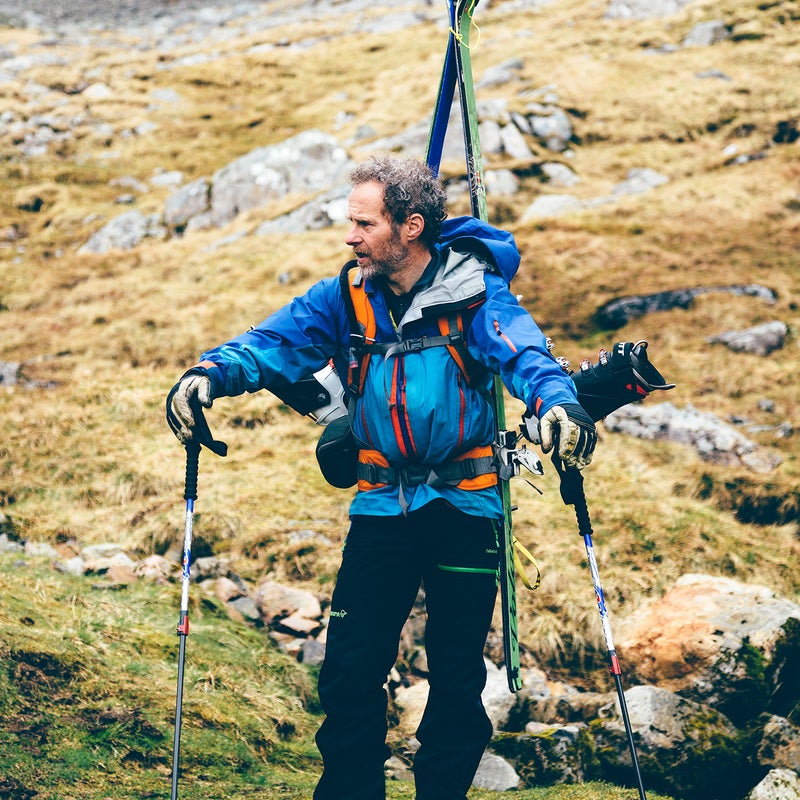
On Friday: still iffy. “It’s four degrees here now”—39.2 degrees Fahrenheit—“so that must be bringing down more snow on the hill,” she said. “As long as winds are not horrendous, I reckon we will get a race somewhere.”
That was all the certainty I would get. I took a train north that night.
There was no snow on the platform at Aviemore this time. Tickets to Fort William, the nearest station to Nevis Range, had sold out, but I arranged to catch a lift with Jim Savege, the chief executive of Aberdeenshire’s town council. Savege was driving over from the east coast and passing through. He’s originally from England, but he had Scottish grandparents and has immersed himself in the country’s ski culture since he moved north in 2015.
He drove us past wet, cloud-plugged glens toward the west coast. Across Scotland, organizers who had put together ambitious ski programs and races based on previous good years were giving up in the face of the 2016–17 snow drought. The Scottish Freedom freeride event, scheduled for that weekend at the Glencoe Mountain Resort, had just been postponed. Still, ski-mountaineering races require only a narrow track of snow to skin along on—and Gilbert got what she needed.
At Nevis Range, there was no snow at the base station of the gondola. At the top station, there were patches and a handful of pistes open, but by no stretch could the place be called a snow-covered mountain. At a chairlift in the rain, I met up with Kenny Biggin, author of off-piste guidebooks to Ben Nevis and Glencoe. Later we spoke inside a slopeside café, and he had the acute look of a parent hoping to exhibit his child’s skills—in spelling, a sport, whatever—on a day when the child was determined not to perform.
“I mean, you can see for yourself that if you’re coming up from London it’s a nightmare, because unless you happen to get lucky with good conditions, or you’re really keen, then it’s hard,” he said. “But for us who live close to it, you can wait for the good days and then just go. Look out the window in the morning and go.”
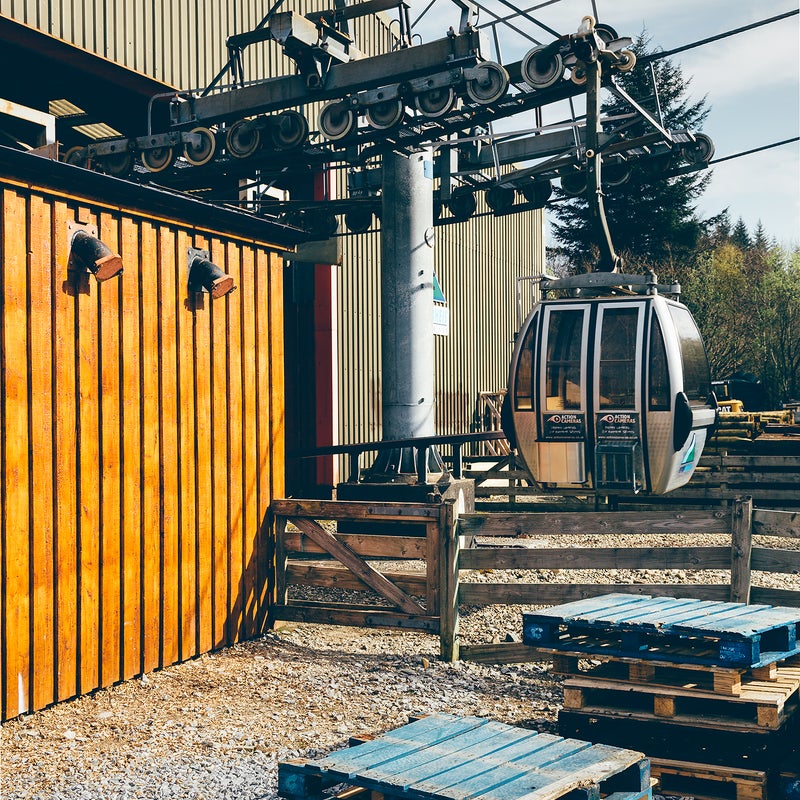
March 18 was not a good day. During the pre-race briefing, we gathered in driving rain outside the café. “The plan today is we’re all going to have a little adventure,” said Gilbert, who completed the Seven Summits in 2010. She gave a lengthy exposition of the route. Having never visited the mountain before, I found it incomprehensible.
“At the top of the summit tow, the top of the mountain, basically, there is no marshal. It’s too grim,” she said reassuringly. “But ski patrol have barriered off the area, so you can’t go into that off-piste place and die.”
The advertised course was about five miles long, with some 3,117 feet of climbing. (Conditions forced organizers to shorten it somewhat.) The field was 19 skiers strong; many wore speed suits and had race skis. I used a heavy, beat-up old pair of Atomic all-mountain skis.
Once the race got under way, we dashed through bogs and mud carrying our skis, then skinned up a lift track and descended on sketchy snow. Marshals ringing bells loomed out of scant visibility. The event was brutal. When I returned one hour, 19 minutes, 28 seconds later, sodden and absolutely exhausted, Gilbert cheerfully informed me: “It’s an acquired taste.”
As we prepped gear in the parking lot, the sky leaden overhead, I asked if I should pack sunscreen. They looked at me as if I’d proposed bringing a rhinoceros.
The day’s champion was Finlay Wild, a whip-thin mountain runner who has won an annual footrace up and down Ben Nevis seven times. In the snowy winter of 2010, Wild, along with his mountain-guide father, Roger, completed a “Scottish haute route” across the country, from Ben Nevis to the Cairngorms, a feat last achieved on skis in the altogether snowier 1970s. Even in the lavish year of 2010, this venture was somewhat sketchy.
“Up in the mountains we were on skis,” Finlay recalled. “Down in the valley sometimes, we were hopping between patches, on heather. Actually, as you’ve seen today, you can ski with remarkably little snow. There was a lot of grass in some of that traverse. One part we were down low, all the snow in the valley had melted, but the river was still frozen, so we skated down the river with grassy banks on each side.”
“We only had to do five or six kilometers of solid walking out of the whole trip,” Roger interjected. “Because all you need is a strip.”
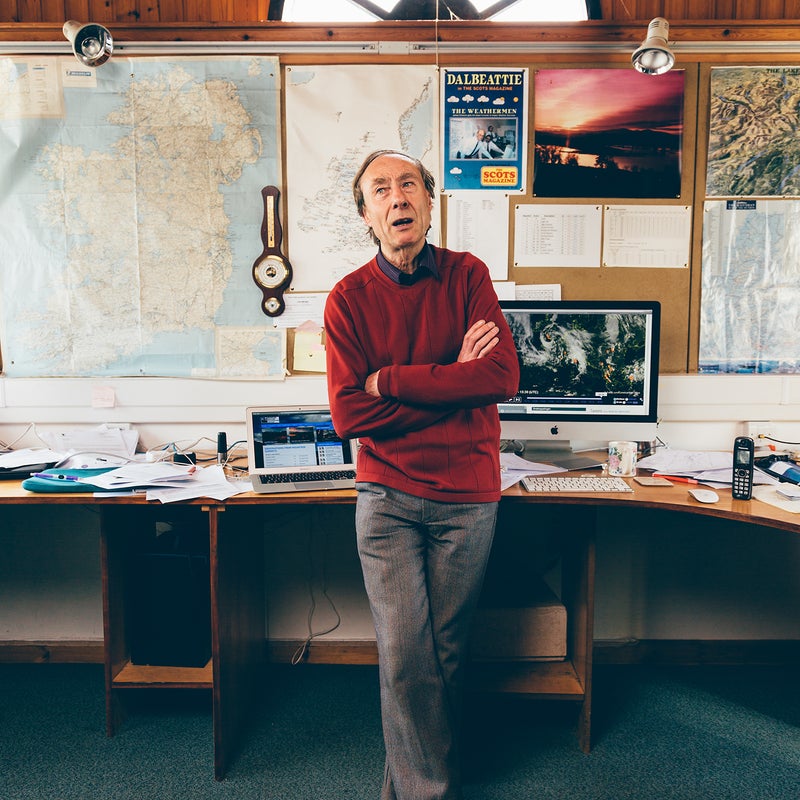
The Wilds are impressive athletes, but as I looked back on Scottish skiing in general, I couldn’t help but think: There’s a kernel of insanity to all this. You can buy a round-trip ticket from Edinburgh to Switzerland for between $80 and $180.
Perhaps the best way to understand such determination to ski is to see it in the context of Scottish culture. That night, in my hotel in Fort William, I watched coverage of the spring conference of the Scottish National Party, which failed three years ago in a referendum that would have broken Scotland away from the United Kingdom. In both skiing and politics, I witnessed a drive to pursue a dream, despite conditions that outsiders might regard as prohibitive.
For my final journey to Scotland, at the end of April, the destination was a well-maintained hut below Ben Nevis, under the mountain’s north face at 2,231 feet. It was the closest British equivalent to a real Alpine hut, with mattresses, propane for cooking, and a wind turbine providing electric light. The walk in was stiff, and from a distance there appeared to be no snow at all on the mountain above. I was with the Inverness Club, and the goal was to try the steep gully skiing that had attracted recent attention online.
This element of the Scottish sport is not new—an early proponent was a man named Harry Jamieson, a fly-rod maker whose client list included Robin Williams, Nick Faldo, and Prince Charles. In the 1980s, Martin Burrows-Smith, then the chief instructor at Glenmore Lodge, expanded the practice using the long skis of the time. “The technical skills of steep skiing must be perfected somewhere absolutely safe,” he warned crisply in the London-based Alpine Journal. “Clearly it would be foolish to experiment at the start of a long and serious descent.”
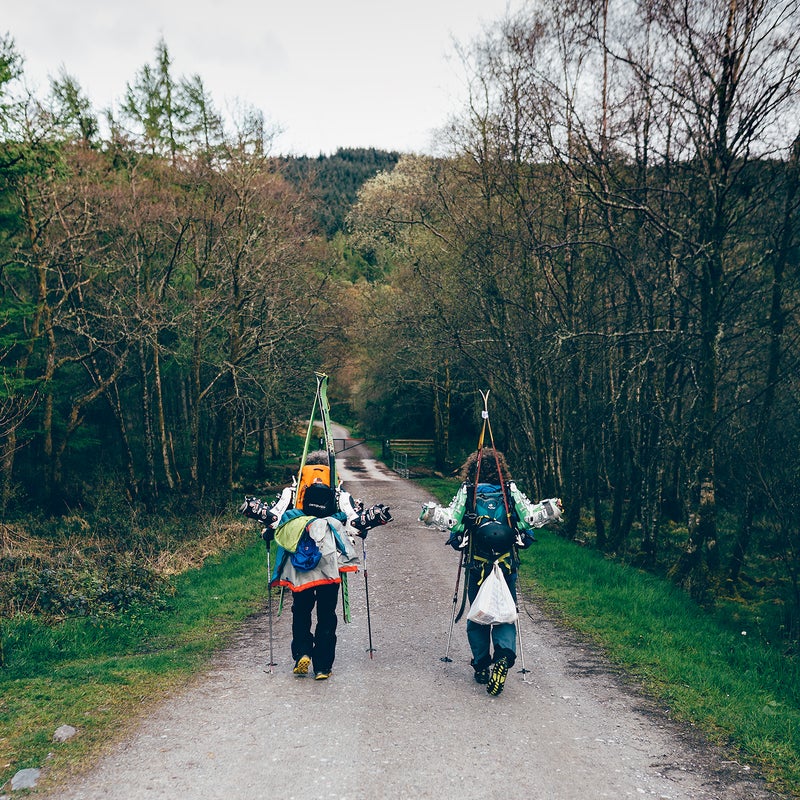
The landscape was extraordinary. During our approach, the valley seemed wholly free of snow except for tiny filigrees on the summit crags of Ben Nevis. Closer in I saw that the north-facing gullies, which gather snow blown over the summit, were well lined, though less so than in big years.
On Saturday, Number Four Gully was skiable. From a small lake at the bottom, we headed up Number Three, which rises to 4,003 feet. I hacked through the top section with my ice ax and promptly thought better of skiing it, so I downclimbed and waited for the others. The Doigs dropped in and made their descent, trouble-free. As Hamish Frost followed, he fell and cartwheeled past me for around 65 feet, his head narrowly missing a rock. He was unhurt but shaken. My recorder was on, the microphone picking up wind noise and the screeching of skis as he flew past, yelling, “W��Dz�!”
“Oh fuck,” I said. “Hamish, you OK?” I yelled up to the others that he appeared to be moving.
“Where’s my ski got to?” Hamish asked from below.
“Your ski’s here with me, as is your pole,” I shouted.
“Think I got my tips crossed,” he said.
The incident drove home the fact that gully skiing can be dangerous. Later I discussed it with Rob Edmonds, founder of the Aviemore ski-touring shop Mountain Spirit and a longtime observer of the Scottish scene. “Down couloirs, if you fall you can bloody hurt yourself,” he said.
Yet for all their hazards, gullies accumulate windblown snow and are more viable to ski in marginal years than open hillsides. Try as you might, 2016–17 was not a winter for long traverses. Going forward, gullies may present the most reliable backcountry terrain.
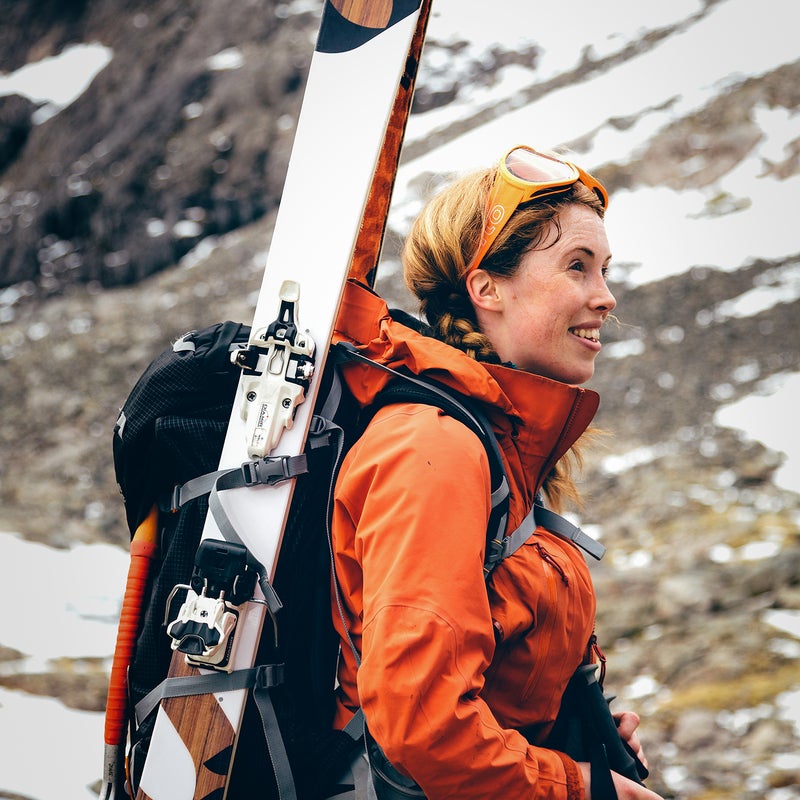
That night we drank whisky that we had hauled up to the hut and dined magnificently on Nicola Jackson’s “super mountain meal,” a concoction featuring quinoa, grated zucchini, ginger, chorizo, feta cheese, and finely chopped spring onion. After dinner I consulted the avalanche logbook, where visitors recorded slides. One was described as “human triggered, as long as Andy is considered human.”
The next day, we clambered up Observatory Gully. Graham Doig dropped a pack by mistake, which pinballed down at great speed, demonstrating the exposure of the terrain. Two of the party, not liking the steeps, waited below. I headed up toward Gardyloo Gully, which branches off to the left, standing on my front crampons while army officer Niall McPherson got primed to descend from partway up.
Lower down, where the snow ribboned among the rocks, we encountered a couple skiing beautifully. Predictably, they were French: 26-year-old Johan Malleval and 28-year-old Valérie Berthet, both from the Alpine town of Chambéry. They had made a bizarre vacation plan and chose to come ski in Scotland.
“We have a camper van. We slept in a parking lot, and we left at eight in the morning,” Malleval said in French.
“When we set off, we thought: There’s no snow. But finally there was snow, and it was very good,” Berthet added. “But a lot of wind today.”
Berthet was preoccupied by the weather. “Is there always wind like this here?”
I translated for the others. Hamish Frost, below us, looked up and, with the benefit of local experience, casually said: “Sometimes it’s windier.”
British writer Simon Akam () is the author of a forthcoming book on the british military, The Changing of the Guard. Ben Read () is an ���ϳԹ��� contributing photographer.
